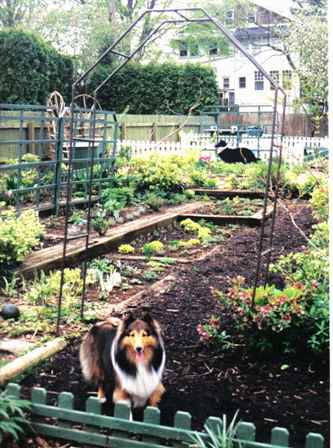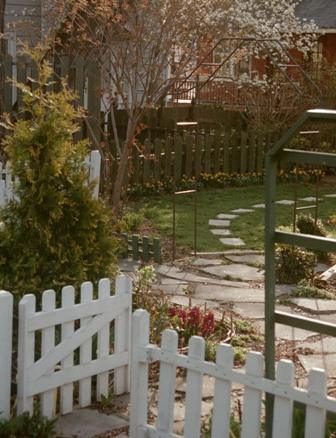 I think we can all agree that planning and installing permanent paths before plunking any plants in the ground is generally the ideal way to get a new garden off to a great start, design-wise. The reality, though, is that most of us are lured into gardening by plants rather than by paving. Have you ever heard anyone say: “Gee, I’d really love to add some color to my yard. I think I’ll go buy some bricks”? I think not. We decide where we want a garden, dig up the turf or pile stuff on top of it, and plant. If we’d stop with that one area, paths would be a non-issue. But when we add another bed or border close by, we also create an “in between” space: a path created by default, rather than by careful planning. That’s not necessarily a bad thing, because default paths can be quite practical. They end up being where they are because you (hopefully) placed your plants in spots where you thought they’d look good without interfering with access to your yard.
I think we can all agree that planning and installing permanent paths before plunking any plants in the ground is generally the ideal way to get a new garden off to a great start, design-wise. The reality, though, is that most of us are lured into gardening by plants rather than by paving. Have you ever heard anyone say: “Gee, I’d really love to add some color to my yard. I think I’ll go buy some bricks”? I think not. We decide where we want a garden, dig up the turf or pile stuff on top of it, and plant. If we’d stop with that one area, paths would be a non-issue. But when we add another bed or border close by, we also create an “in between” space: a path created by default, rather than by careful planning. That’s not necessarily a bad thing, because default paths can be quite practical. They end up being where they are because you (hopefully) placed your plants in spots where you thought they’d look good without interfering with access to your yard.
 After a few years of creating new gardens, you look around and realize that you’ve created a network of garden paths, too. Chances are, some of them you really like, and others just aren’t quite right. Then it’s decision time: Do you just live with them, do you try to fix up the problem paths yourself, or do you call in a professional designer for some major upgrades? Or, do you solve the problem by moving away from that garden altogether and starting fresh on a new site, taking advantage of what you’ve learned in your previous garden to create paths that are both practical and pleasing? It’s not a solution that I’d recommend to everyone, but it worked for me.
After a few years of creating new gardens, you look around and realize that you’ve created a network of garden paths, too. Chances are, some of them you really like, and others just aren’t quite right. Then it’s decision time: Do you just live with them, do you try to fix up the problem paths yourself, or do you call in a professional designer for some major upgrades? Or, do you solve the problem by moving away from that garden altogether and starting fresh on a new site, taking advantage of what you’ve learned in your previous garden to create paths that are both practical and pleasing? It’s not a solution that I’d recommend to everyone, but it worked for me.
 My previous garden was quite small, and in seven years, I’d managed to fill pretty much every available space. The pathways were necessarily narrow, to allow as much space as possible for my ever-expanding plant collection, and they didn’t have to be wide anyway. Wheelbarrow access wasn’t an issue, because I could easily carry any debris the few steps to the compost bins. For the most part, the path routes were planned by Gwennie, my incessantly active (and now terribly missed) Sheltie, who worked off a good bit of her happy-puppy exuberance by running endless laps around the yard. In spots where I needed to extend a bed into her established orbit, I incorporated a piece of agility equipment, such as a hoop for her to jump through or a ramp or bridge for her to scramble over, to protect the plants without spoiling her fun. It was also necessary to add a stepping-stone arc through the tiny strip of lawn to replace her nail-worn dirt track, and some additional flat stones on the turns, along with some Mom-crafted, mini-picket-fence edgings to keep the bark mulch from scattering onto the plants. It was all a little eccentric, perhaps, but it worked for us.
My previous garden was quite small, and in seven years, I’d managed to fill pretty much every available space. The pathways were necessarily narrow, to allow as much space as possible for my ever-expanding plant collection, and they didn’t have to be wide anyway. Wheelbarrow access wasn’t an issue, because I could easily carry any debris the few steps to the compost bins. For the most part, the path routes were planned by Gwennie, my incessantly active (and now terribly missed) Sheltie, who worked off a good bit of her happy-puppy exuberance by running endless laps around the yard. In spots where I needed to extend a bed into her established orbit, I incorporated a piece of agility equipment, such as a hoop for her to jump through or a ramp or bridge for her to scramble over, to protect the plants without spoiling her fun. It was also necessary to add a stepping-stone arc through the tiny strip of lawn to replace her nail-worn dirt track, and some additional flat stones on the turns, along with some Mom-crafted, mini-picket-fence edgings to keep the bark mulch from scattering onto the plants. It was all a little eccentric, perhaps, but it worked for us.
 Eventually, though, the lack of space for new plants (among other issues), made moving an option worth pursuing. Gwennie ended up with daily access to dozens of acres of woods and fields to run through, and I ended up with a blank slate to start a garden on. Over the last six years, I’ve once again ended up with a variety of paths—this time, more by planning than by default, and mostly I’m pleased with them. In my follow-up post, I’ll show you what I’ve ended up with. But to finish for now, a reminder of the temporary nature of our beloved gardens. A few weeks ago, a friend and I needed to visit the town I used to live in, so we took a few minutes to walk along the alley that fronts my old house. The picture below was taken from the same spot as the second picture from the top of this post, but at a slightly different angle. It didn’t turn out very well, but maybe you’ll get the general idea: pretty much everything but the perimeter fence and the greenhouse is gone, and the garden is mostly lawn grass once again. Sigh.
Eventually, though, the lack of space for new plants (among other issues), made moving an option worth pursuing. Gwennie ended up with daily access to dozens of acres of woods and fields to run through, and I ended up with a blank slate to start a garden on. Over the last six years, I’ve once again ended up with a variety of paths—this time, more by planning than by default, and mostly I’m pleased with them. In my follow-up post, I’ll show you what I’ve ended up with. But to finish for now, a reminder of the temporary nature of our beloved gardens. A few weeks ago, a friend and I needed to visit the town I used to live in, so we took a few minutes to walk along the alley that fronts my old house. The picture below was taken from the same spot as the second picture from the top of this post, but at a slightly different angle. It didn’t turn out very well, but maybe you’ll get the general idea: pretty much everything but the perimeter fence and the greenhouse is gone, and the garden is mostly lawn grass once again. Sigh.
